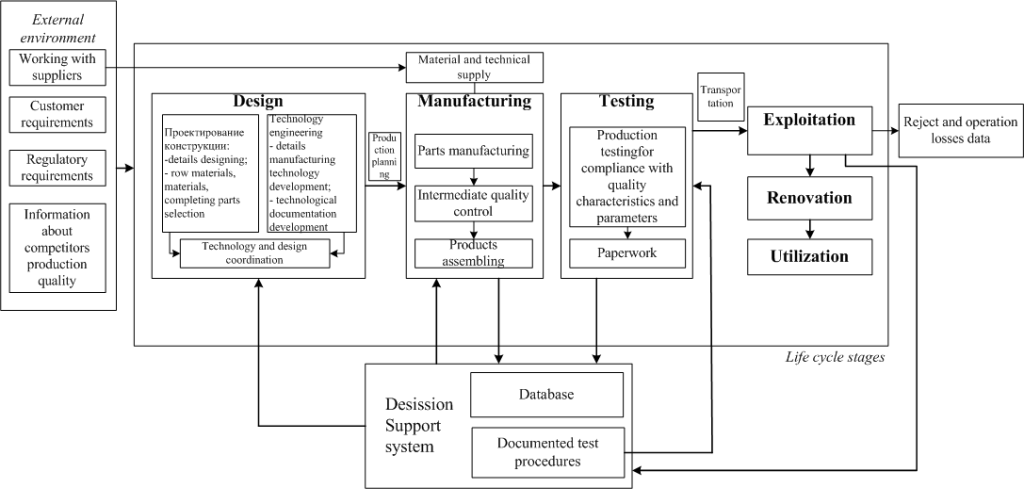УПРАВЛЕНИЕ КАЧЕСТВОМ И ПРИНЯТИЕ РЕШЕНИЙ ПРИ ПРОИЗВОДСТВЕ ИСКРОВЫХ СВЕЧЕЙ ЗАЖИГАНИЯ
Лютов А.Г.1, Ильин А.Н.2, Филонина Е.А.3
1 Доктор технических наук, профессор, 2 кандидат технических наук, доцент, 3 аспирант, Уфимский государственный авиационный технический университет
УПРАВЛЕНИЕ КАЧЕСТВОМ И ПРИНЯТИЕ РЕШЕНИЙ ПРИ ПРОИЗВОДСТВЕ ИСКРОВЫХ СВЕЧЕЙ ЗАЖИГАНИЯ
Аннотация
Объектом исследования являются искровые свечи зажигания двигателей. В качестве элемента свечи, определяющего ее основные эксплуатационные параметры, рассмотрен резистивный герметик. Выявлены параметры свечей зажигания, влияющие на качество розжига и запуска. Рассматриваются вопросы разработки системы поддержки принятия решений по обеспечению качества для жизненного цикла свечей зажигания.
Ключевые слова: искровые свечи зажигания, резистивный герметик, управление качеством, жизненный цикл продукции.
Lutov A.G.1, Ilin A.N.2, Filonina Е.А.3
1 PhD in Engineering, professor; 2 PhD in Engineering, associate professor, 3 postgraduate student, Ufa State Aviation Technical University
THE QUALITY MANAGEMENT AND DECISION MAKING FOR SPARK PLUGS MANUFACTURING
Abstract
The engine spark plugs are investigated. The resistive sealant is considered to be the element of the plug which determines its base operating parameters. Spark plugs parameters, affecting the ignition and starting quality are identified. The decision support system of ensuring the spark plugs manufaсture quality development quastions are discussed in the article.
Keywords: spark plugs, the resistive sealant, quality management, product life cycle.
Meeting the requirements of internal combustion engines emissions environmental friendliness ensuring plays an important role today. It is known that the correct adjustment of the engine allows to reduce the amount of СО and CH emissions. It is related to ignition systems operating modes. Spark plugs are among the important elements of internal combustion engines, rotary engines and piston engines ignition systems. They are intended to ignite the combustion mixture in the cylinders by using the spark discharge. Starting properties, reliability, power, fuel economy and exhaust gases toxicity of the engine essentially depend of design excellence, manufacturing quality and proper selection of the spark plugs. Therefore the problems of spark plug manufacturing stability and the effective use of its power are actual.
However, despite of increased attention to the environmental friendliness, the tendency of spark plugs quality requirements reduction at different stages of production is observed presently. Conventional spark plug production technological schemes do not consider the current tendency of production quality improving. The prolonged technological cycle, large manual labor share and high cost of final product feature spark plugs production in Russia today. Technological wastes related to defects are high. These factors taken together sharply reduce the spark plugs manufactured in Russia competitiveness. Thus, there is a need for the new design and technological solutions development and introduction, which are focused on the high level of automation of spark plugs manufacturing and control processes.
In Russia the federal Technical Regulation law makes the following quality demands in relation to spark plugs manufacturing:
- heat rating number (it determines the heat range of spark);
- noise immunity, operability and compatibility with electrical devices (due to the embedded resistive sealant);
- tightness of spark plug on the case and through the central electrode electrical circuit (also due to the resistive sealant);
- reliable coating of metal components;
- required operating life of spark plug [1].
The majority of these tasks requires solutions during the design phase. The most difficult problem of quality assurance is the required spark plug resistive properties and its tightness compliance. These factors are determined by manufacturing technology of the spark plug, its design and manufacturing process stability.
The analysis of Russian Federation normative documents shows that for today there is significant remission of requirements in relation to spark plugs at different stages of the life cycle [2]. The electrical resistance should be checked at all stages of spark plug testing, because its instability is observed during the manufacturing process. Accordingly, identifying the causes of electrical resistance instability is the urgent task for spark plug quality management and for passing subsequent certification procedures.
Fig. 1 – Spark plugs life cycle stages support system structure.
The electrical resistance of sealant as cermet element is traditionally considered to be determined by a set of its components. There is no well-ordered data about correlation between these components concentration and electrical resistance value for today. In the present study [3] we assume that spark plug electrical resistance obeys the Ohm's law, because the spark plug is electrical circuit element in the ignition system. However, this assumption requires its confirmation or disproof.
Moreover, there is temperature influence on the spark plug resistive properties during the manufacturing process. The temperature factor occurs during engine operation also. Thus, tasks of the quality management and decision making system (fig. 1) for the spark plug manufacturing is following: to consider factors influencing the spark plug electrical resistance stability:
a) constructional factors;
b) technological factors;
The resistive sealant electrical resistance can vary over a wide range according to components percentage content in mixture, the supplied raw material level of enrichment and other factors.
References
- Automobile items. Spark plugs. Technical requirements and methods of testing, (in Russian), Federal standard R 53842-2010, Moscow, Standatrinform, 2010.
- Federal low «On technical regulation», (in Russian), Federal law, Moscow, Kremlin, 2002.
- A. N. Ilin, E. A. Filonina, «The control system of resistive sealant production process design», in Proc. 4th Conference on High technology in engineering and aviation engine construction, 2012, vol. 2, pp. 335-340.

